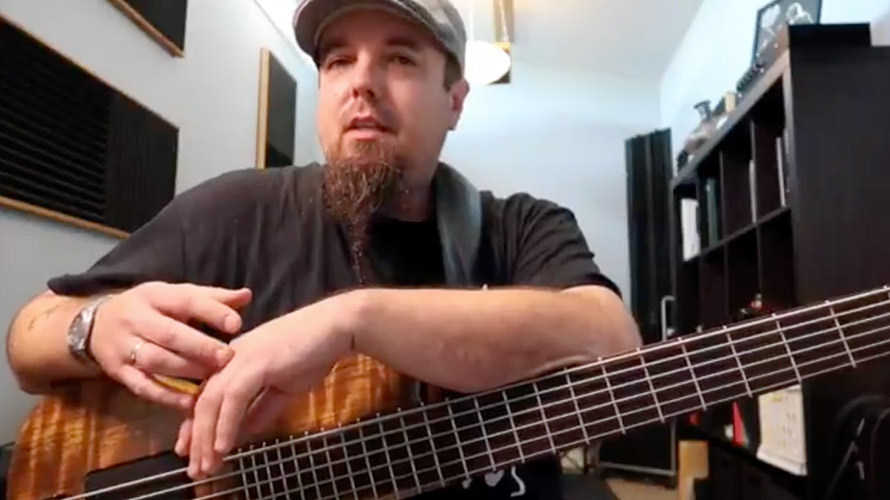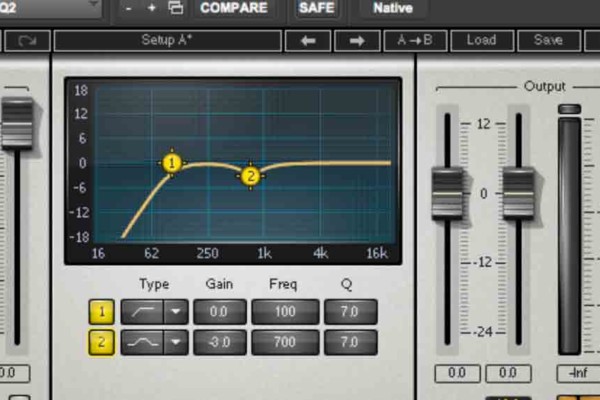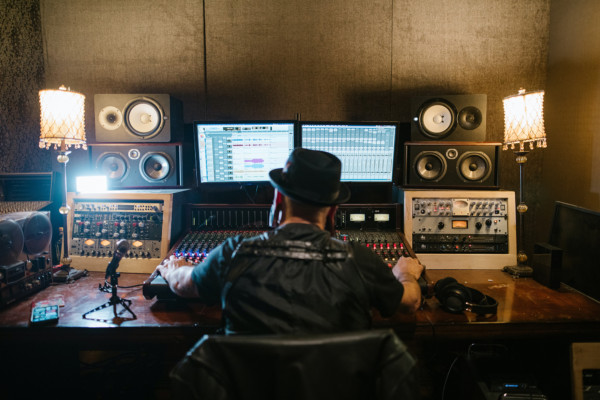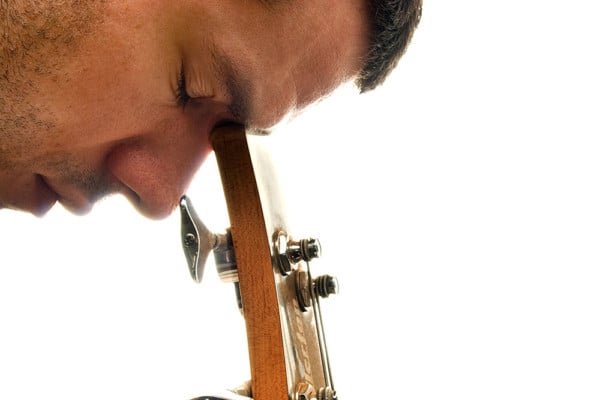Recording Audio and Video

Q: I want to record audio/video simultaneously that I can easily post to social media. I’d want the range to go from solo bass pieces or pedal reviews recorded at home to live coffeehouse/house party “warts and all” mono live duo/trio recordings. I’d want to use two cameras for close-ups on the solo pieces/demos and two/three angles of video for duo/trio gigs to add interest (via editing, another variable) which easily syncs to the sound. Is this too much to ask? I’m a bit of a technophobe, I’ll be 47 in May and I’ve finally gotten along far enough on the bass that I should spend a bit of time learning the tech that’ll pay dividends, but I’m hoping on some direction.
A: This question comes at a perfect time, as I’ve been experimenting in my home studio with different setups, camera placements, lights, editing software, storage solutions, and more. All in an attempt to start creating content that isn’t quite as obviously “homemade” as much of what is out there from me.
I can tell you that you can quickly go crazy trying to figure out what gear you’ll need and how to manage your workflow so that you can actually spend more time creating content and less time futzing with gear and trying to organize your content.
The first thing to consider is your gear:
- How many cameras?
- How much storage? (Remember that redundant backups are a must. I use a combination of hard drives as well as cloud storage)
- Lights
- Mic(s)
- Mounts for mics, cameras and lights as necessary
- Editing software
I think that it’s best to start small and experiment, discovering what you need as you go. It’s too easy to drop thousands of dollars and wind up with a pile of gear that you only use a portion of once you really get going.
Most of the better do-it-yourself-ers I know use one or more DSLR cameras to get that cinematic quality video. I was hesitant to drop major dough on a DSLR until I had things figured out and had recommended to me a Canon G7X Mark ii. I happened to find one on sale while on the road in Asia and jumped at the chance. It’s a fantastic camera and the video quality is stunning (even compared to cameras that cost twice as much).
I use this as my primary camera and then use my phone, an old Go Pro that I had, or my Zoom Q4n as secondary cameras for close-ups, etc. Ultimately, I’d probably buy another Canon G7x as the video quality is far better than any of my other cameras (the GoPro looks great outside but I’ve learned that the lighting has to be just right otherwise it’s just not happening and I’ve never been able to get it looking anything better than ‘…meh’, in my home studio, even with lighting).
Likely, the most crucial piece of gear (outside of your camera) will be your lighting. I have a few dimmable, bi-color LED lights on stands. These allow you to really dial in the perfect lighting, both because you can adjust the intensity, but also because you can separately adjust the warmer yellow bulbs and the brighter white bulbs to get a good coloration. Having multiple lights is pretty key. You’ll want one as your primary and then another one (or two) coming from different angles to get rid of shadows and add depth. I’ve taken to making sure that I’m a foot or two away from my background and keep a light on behind me as well (hidden) as it adds depth to the frame.
Now comes the choice of mic. Some people use lapel mics, some use shotgun mics, some just use their built-in camera mics. I had issues with the lapel mics because they kept rubbing against my beard (I actually had to throw away hours of video because of this. Lesson learned. Run a thorough test shoot before you invest too much time into a video!) I was about to buy a shotgun mic and then, on a whim after a few hours researching different mics, wound up buying a headset mic. It sounds great and was very affordable. The only downside is that it might look a little dorky (Janet Jackson, I’m not). I very well may pick up a shotgun mic one of these days. They seem to work pretty darn well and they can also mount right up on the camera.
As far as storage goes, I bought a solid 5TB hard drive as my work drive and a primary storage drive (figuring that I’d just get another if I got deep into the content creation thing and needed more space). I also have unlimited Google Drive space because I’m a Berklee Alumni (Berklee grads, look into that! It’s free for us!), so I use that as additional storage of my edited files. I upload everything to Google Drive at the end of any recording/editing session. I also use a 2TB drive to record my audio via Logic. Don’t just record things on to your internal hard drive.
After a bit of research, I decided on Final Cut Pro for my video editing. It’s pretty easy to learn and there are a ton of tutorials on YouTube. Once you get a few hours in, it becomes pretty intuitive. FCP also makes it a breeze to sync multiple video and audio clips so you don’t have to worry too much about that side of things as long as you organize your data dumps well.
I also use Logic to record my audio. I was a Pro Tools guy but I stupidly upgraded my home computer without thinking and, lo and behold, PT didn’t work anymore. Ultimately, I just bought Logic and have been using it ever since. I still prefer Pro Tools but Logic is solid and just takes a little while to learn the architecture. I run my bass through my RedDI tube DI and run my mic straight in. I also have a third channel that I use for my phone when playing to a metronome or play-along track.
Make sure to keep audio running on all of your cameras as well. It makes syncing your clips much easier and I also usually let a little of the room mics live in the final mix so that things don’t sound too dry.
As you can imagine, with multiple cameras and three channels of audio, it’ll be important that you organize things pretty well as you go. I start a new folder for each day, which contains separate folders for each camera/audio source. As I record, I stop and start everything when I have to start and stop anything. I try to have the same number of clips form each source and then a number or label them well when I dump the cards into my computer. Side note, when I dump one thing, I dump them all, labeling as I go. I’ll usually format all of the cards and start over, so each batch is unique and there’s no chance of me duplicating any video takes across folders.
There is no lack of bassists in the community that are creating stellar content. Many of them also have blogs and vlogs and have written or filmed content specifically about creating content. It’s worth checking out what’s out there to get an idea of what is entailed.
I really hope that some of our more savvy readers can help us out here and give us some pointers. What did I miss? Please share in the comments.
Have a question for Damian Erskine? Send it to [email protected]. Check out Damian’s instructional books, Right Hand Drive and The Improviser’s Path.



